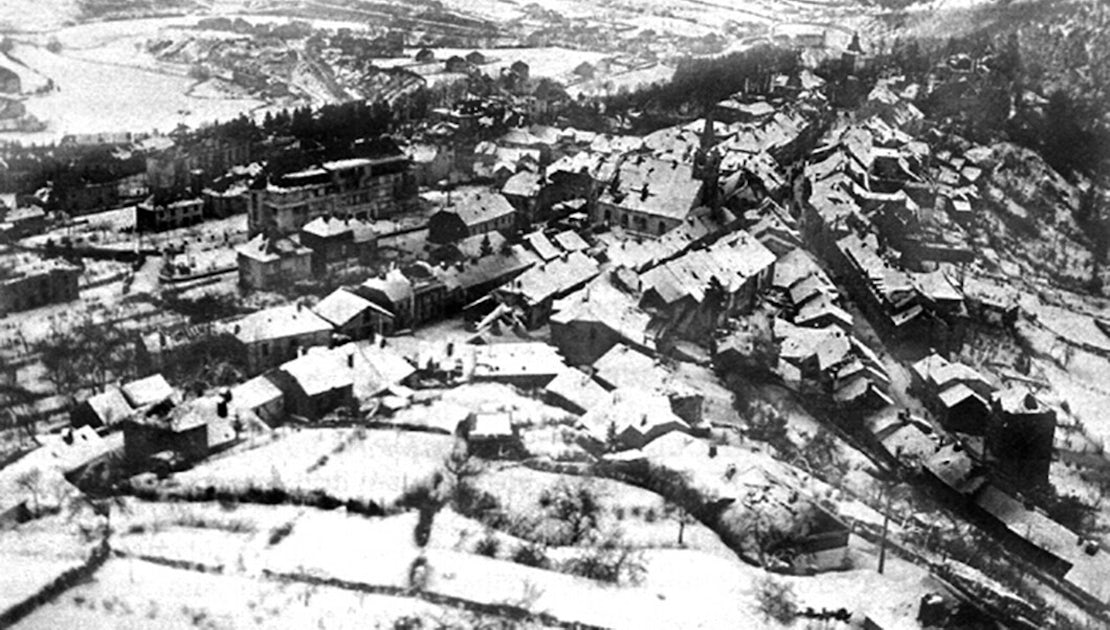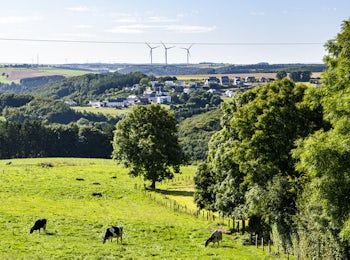
It came as a complete surprise to the 83,000 American soldiers. In the centre of the German offensive, the GIs of the 28th American Infantry Division delayed the advance of the Wehrmacht (German armed forces) in the towns of Hosingen, Holtzthum and Consthum. However, Colonel Strickler was forced to withdraw through Kautenbach to Wiltz, where the headquarters of the 28th Infantry Division under the command of General Da Cota were located. On 19 December 1944, the town of Wiltz was taken by German troops. The Americans were forced to withdraw via Mount Schumann, which was already under German control, to the headquarters in Sibret in Belgium.
It was in the forests of Schumann's Eck that the cruellest fighting of the Battle of the Bulge took place between 19 December 1944 and 21 January 1945.
It was a truly horrific time for the inhabitants of Wiltz, who, given how close the fighting was, were forced to hide away in their cellars. Eighty per cent of the houses were destroyed or damaged and 50 people were killed during the Battle of the Bulge.
It goes without saying that a museum was founded after the war, in memory of the many victims of the Battle of the Bulge.

It is important to remember that, on 10 May 1940, Luxembourg fell under occupation by the Germans, who tried in vain to integrate the Luxembourgers into the "Reich". The inhabitants of Wiltz were the first to strike against the forced conscription decreed on 31 August 1942 by the "Gauleiter" (regional Nazi leader), which cost the lives of six Wiltz citizens. It was only on 10 September 1944 that Wiltz was liberated for the first time by the Americans. On the ground floor of the Battle of the Bulge Museum, you will see scenes from the daily life of American soldiers and the people of Wiltz. On the first floor, you will discover the American St. Nicholas, the musicians of the 28th Infantry Division and the promise of the dean of Niederwiltz in his cellar.
The third floor showcases the horror of total war in Schumann's Eck – the scene of the deadliest battles.
In addition, you will discover photos, uniforms, documents, small war items and the engine of a tank on display at Place Belle-Vue in Wiltz.
On-screen videos guide you through the events.
A visit to the museum is therefore highly recommended during your next visit to Wiltz.
Wiltz - A place of remembrance and tribute

When driving around Wiltz, you will inevitably come across the "Schumanns Eck". The Schumanns Eck is the intersection of the roads linking Ettelbruck and Bastogne as well as Wiltz and the Upper Sûre lake. Many people pass every day on these busy roads, but few know that they are crossing the scene of one of the cruelest moments of the Battle of the Bulge.
16 December 1944
Everyone was convinced that with the liberation of Petange on 9 September 1944, the war was over. However, 3 months and seven days later, the German army launched an attack against all odds in the Ardennes.
In the winter of 1944-1945, one of the harshest winters of the century, the villages in the north of Luxembourg and the Schumanns Eck were the scene of terrible fighting. As long as it was still possible, hundreds of inhabitants fled the Eislek in American buses and trucks to the south of the country. For those who remained, daily life was organised between the shootings: children went to school and mothers did the laundry and cooked lunch. Around them despair and misery, fields of ruin and death.
12,000 Luxembourgers were forcibly asked to join the German ranks. There were three options: to refuse to join the enemy army, to join it with the intention of deserting later or to join the Wehrmacht and fight to the end.
After having broken through the encirclement of the town of Bastogne on 26 December 1944, General Patton's 3rd US Army attacked the German forces in the Harlange pocket up to the Schumann Crossroads.
On 30 December 1944, the 26th American Infantry Division reached the Schumann Crossroads, where it met the fierce resistance of the 9th "Volksgrenadier Division" entrenched in the woods. The battlefront froze and for a fortnight American attacks and German counter-attacks alternated. The soldiers were decimated by fierce hand-to-hand fighting and by artillery and machine gun fire. It was the deadliest and bloodiest fighting on Luxembourg soil.
Brought in secretly, the US 90th Infantry Division attacked on 9 January 1945 with the 26th Division to take Berlé and the next day Pommerloch.
It wasn't until 21 January 1945 that the town of Wiltz was liberated by the 26th Infantry Division and the 6th US Cavalry Group.
The NATIONAL LIBERATION MEMORIAL at the Schumanns Eck was inaugurated on the 50th anniversary of the liberation in September 1944 and February 1945 by American troops.
Over a distance of almost three kilometres, 65 life-size silhouettes of soldiers and civilians who were present during the Ardennes offensive were installed. This project required years of research. The photos used for the silhouettes were taken from American and German soldiers. The trail provides detailed information on the type of weaponry used and is dotted with photos that accurately portray the authenticity of this crucial battle. The trail is worth visiting out of respect for history, but also for its cultural and educational nature, which is not without a certain aesthetic appeal. Not to be missed under any circumstances!
The town of Wiltz and its surroundings are full of monuments that pay tribute to the bravery of the population and the soldiers involved in this ferocious battle. From Bastogne to Diekirch, many museums, including the one in Wiltz, tell in detail the events that were crucial to the outcome of the conflict and, thanks to their rich collections, plunge you back into the terrifying atmosphere of this final battle. Wiltz, at the crossroads, offers you a unique starting point for your journey into history and remembrance.















